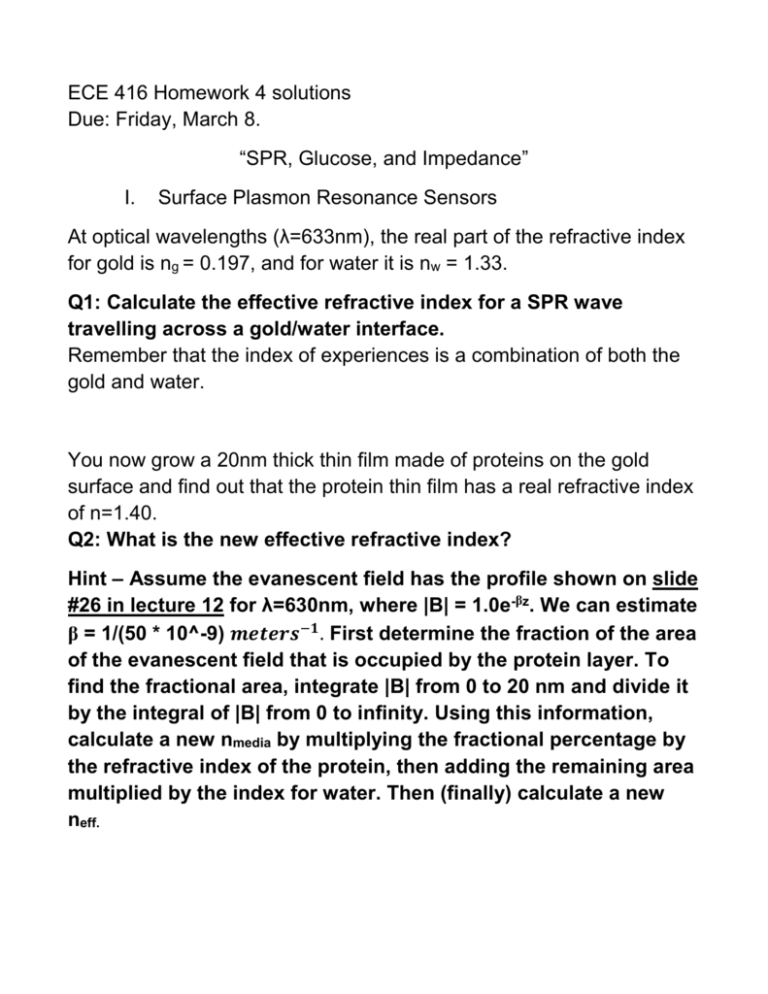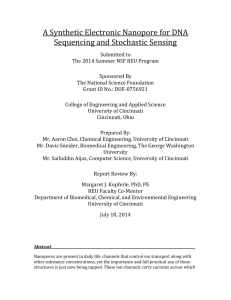Calculate the effective refractive index for a SPR wave
advertisement

ECE 416 Homework 4 solutions Due: Friday, March 8. “SPR, Glucose, and Impedance” I. Surface Plasmon Resonance Sensors At optical wavelengths (λ=633nm), the real part of the refractive index for gold is ng = 0.197, and for water it is nw = 1.33. Q1: Calculate the effective refractive index for a SPR wave travelling across a gold/water interface. Remember that the index of experiences is a combination of both the gold and water. You now grow a 20nm thick thin film made of proteins on the gold surface and find out that the protein thin film has a real refractive index of n=1.40. Q2: What is the new effective refractive index? Hint – Assume the evanescent field has the profile shown on slide #26 in lecture 12 for λ=630nm, where |B| = 1.0e-βz. We can estimate β = 1/(50 * 10^-9) 𝒎𝒆𝒕𝒆𝒓𝒔−𝟏 . First determine the fraction of the area of the evanescent field that is occupied by the protein layer. To find the fractional area, integrate |B| from 0 to 20 nm and divide it by the integral of |B| from 0 to infinity. Using this information, calculate a new nmedia by multiplying the fractional percentage by the refractive index of the protein, then adding the remaining area multiplied by the index for water. Then (finally) calculate a new neff. Q3: What is the % change in the velocity of the speed of light for the propagating surface plasmon wave induced by adding a protein layer? The first protein layer is used to capture a second protein layer of identical thickness (20nm) with a refractive index of n = 1.4. Q4: Calculate the percent change in velocity of the speed of light for the propagating surface plasmon wave for this second layer with respect to the velocity after the first layer. Even though both layers have identical thicknesses, why do they yield a different velocity reduction? (Hint: calculate a new n, just as in the above section. Then think about the shape of the evanescent field, and what part the protein layer occupies. Drawing the evanescent field over a sketch may help). II. Optical Biosensors 𝜟𝑹 Q5: Calculate the “bulk refractive index shift coefficient” = for 𝜟𝒏 two of the SPR instrument configurations found in the Wolfbeis_145-171.pdf file in Fig 5 and 6. 𝜟𝑹 can represent changes in angle of incidence of maximum surface plasmon coupling (for a fixed wavelength) or changes in the wavelength of surface plasmon coupling (for a fixed angle of incidence). Q6: For Wavelength (Figure 6), estimate the width of the resonant minima by measuring the Full Width at Half Maximum (FWHM) for nD=1.35. (FWHM is defined as the width at 50% of the maximum value (see image below). Q7: Detection resolution is proportional to 1/FWHM of the resonant dip. A ‘figure of merit’ that incorporates sensitivity and 𝜟𝑹 resolution would be FOM = ( )/FWHM. Calculate this FOM for 𝜟𝒏 Figures 5 and 6. Q8: The bulk refractive index sensitivity for a photonic crystal biosensor is 300nm/Refractive Index Units (RIU). Using the plot in slide #37 of lecture 13 compare the FOM for a PC biosensor to an SPR biosensor. III. Nanopore Sensors As their name suggests, nanopores are very small (~20 nm) holes in a surface or membrane. They can act as sensors for single molecules by measuring current in one of two ways. We can monitor the current passing across the nanopore and look for changes as molecules pass through, OR detect the current on single molecules. To detect the current reduction as a molecule passes through the nanopore, we must ensure that the charge on the molecule will not affect the charge on the nanopore and surrounding membrane. Often times these measurements are done in a high density KCl solution that provides a charge buffer on the membrane. This ensures molecules passing through the pore to not have much effect on the charge of the membrane itself. When a molecule enters the nanopore, the local properties change (conductance) and produce a measurable output. Nanopore Conductance (G) can be calculated as: 𝜋 𝑑𝑝𝑜𝑟𝑒 2 4∗𝜎 𝐺= ∗ ∗ ((µ𝑘 + µ𝑐𝑙 ) ∗ 𝑛𝑘𝑐𝑙 ∗ 𝑒 + µ𝑘 ) 4 𝐿𝑝𝑜𝑟𝑒 𝑑𝑝𝑜𝑟𝑒 Where 𝑑𝑝𝑜𝑟𝑒 = 5 nm (the diameter of the pore), 𝐿𝑝𝑜𝑟𝑒 = 50 nm (the length, in depth of the pore), 𝑛𝑘𝑐𝑙 (the # of sodium and calcium ions), e = 1.6*10^-19 coulombs (the elementary charge), µ𝑘 = 7.616*10^-8 and µ𝑐𝑙 = 7.909 * 10^-8 𝑚2 𝑉∗𝑠 4∗𝜎 𝑑𝑝𝑜𝑟𝑒 𝑉∗𝑠 (mobility of the ions in a solution). If the density of KCl in the solution is greater than ignore the µ𝑘 𝑚2 2𝜎 𝑑𝑝𝑜𝑟𝑒 ∗𝑒 , we can term in this equation. See Smeets, et al, “Salt dependence of ion transport and DNA translocation through solidstate nanopores”, NanoLetters 2006 Vol 6 #1 for more info. (I provided the paper reference for those of you who are interested, it is not necessary to read this to solve the problems.) When a strand of DNA moves through the pore the conductance (G) changes an amount proportional to the size of the object passing through it. We can approximate this change with: 𝛥𝐺 𝑑𝐷𝑁𝐴 2 = 𝐺 𝑑𝑝𝑜𝑟𝑒 2 𝜟𝑮 Q9: Estimate the conductance blockade ( ) when a single 𝑮 stranded piece of DNA (𝒅𝒔𝒔𝑫𝑵𝑨 = 𝟐. 𝟐 𝒏𝒎) and also for a double stranded piece of DNA (𝒅𝒅𝒔𝑫𝑵𝑨 = ~𝟐 ∗ 𝒅𝒔𝒔𝑫𝑵𝑨 ). When we look at solutions with low concentrations of KCl the second term (µ𝑘 4∗𝜎 𝑑𝑝𝑜𝑟𝑒 ) becomes more significant. This is due to the molecules passing through the pore increase the charge of the membrane, usually adding a “counter charge” to the pore current. To detect the charge on a single molecule, we have to ensure that there are no or few additional charges in the solution our target molecules, so we traditionally have our molecules of interest in a very low concentration KCl solution. Q10: What happens to the conductance blockade signal (I.E. does it increase or decrease) when a piece of DNA passes through it under low KCl concentrations? Describe your reasoning. You can generalize a piece of DNA passing through a pore as a string with charged particles spaced out evenly along its length. Q11: If DNA contributes 100 picoamps of current to the sensor, estimate how fast the DNA passed through the pore. Assume the separation between base pairs is 0.34 nm and a single base pair passing through the sensor causes an output of 8.5*𝟏𝟎−𝟐𝟎 coulombs (Hint: think of what amperes mean with respect to coulombs, then use dimensional analysis to find a value with units of 𝒏𝒂𝒏𝒐𝒎𝒆𝒕𝒆𝒓𝒔 𝒔𝒆𝒄𝒐𝒏𝒅 .) One practical use of nanopore sensors lies in the detection of DNA that is hyper-methylated. DNA is traditionally precisely methylated (on the cytosine or adenosine nucleotides) to silence its transcription. For example, sections of your DNA that are active when you are growing from an embryo are silenced as you mature. The methyl groups physically block transcription factors from binding to DNA, preventing replication of a specific sequence. DNA methylation is also part of the preparation unwound DNA undergoes for long term storage and compression. However, hyper-methylated DNA is a sign of an unstable chromosome and is more likely to cause the organism to have cancer. Hypermethylated DNA. Note – This image is not to scale. Q12: In a few sentences, explain why the nanopore sensor can sense the difference between “normal” DNA and “hypermethylated” DNA.







